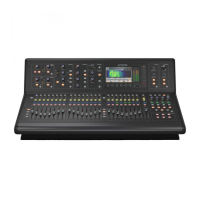Mic:
Abbreviation for ‘microphone’.
Microphone:
Device for converting sound waves into audio signals.
MIDI:
Acronym for ‘musical instrument digital interface’. A
digital signal system standard that facilitates integration of
musical instruments, such as synthesizers and guitars, with
computers.
Mix:
1. A signal that contains a combination of signals, such as a
pair of stereo signals with numerous effects. 2. The act of creating
such a combination.
3.
A type of bus. See Bus.
Mix bay:
Control area for outputs and groups.
Mixer:
1. A console or other device that blends input signals
into composite signals for output. 2. An engineer/technician
who carries this out, especially during a live performance.
mm:
Symbol for ‘millimetre’ (one thousandth of a metre).
MON:
Abbreviation for ‘monitor’, used to describe a control centre
being used to mix the signals sent to the stage monitor speakers.
Monitor:
1. Speaker(s) used for listening to a mix or live audio. 2.
The act of listening to a mix or live audio.
Monitor A:
Primary monitor bus system.
Monitor B:
Secondary monitor bus system.
Monitors:
Control area on the master bay for monitoring
the A and B signal paths.
Mono:
A single signal.
Mute:
Function that allows a channel’s signal to be silenced.
Mute safe:
Function that means a mute cannot be controlled by
scene recall or auto-mutes.
N
N/A:
Abbreviation for ‘not applicable’.
nm:
Symbol for nanometre (one billionth of a metre).
Normalise:
To boost the amplitude of a digital sound so that it is
as high as it can be without clipping (0 dB).
Normalisation:
An automatic process whereby the gain of all
program material is adjusted so that the peak level will just
arrive at 0 dB.
Normalised connection:
Also known as ‘normalled connection’.
A connection that allows a signal to pass through it when no
plug is inserted in it, but breaks the connection when a plug is
inserted.
Normalising:
The process of making audio files the same volume.
NVRAM:
Abbreviation for ‘Non-volatile random access memory’.
this is the general name used to describe any type of RAM that
retains its information when power is switched off. For example,
flash memory.
O
O/B:
Abbreviation for ‘outside broadcast’.
Oct:
Abbreviation for ‘octave’.
Octave:
A difference in pitch where one tone has a frequency
that is double or half of the frequency of another tone.
ohm (Ω):
Unit of electrical resistance.
OpticalCon®:
A cable connector for fibre optic cables.
OS:
Abbreviation for ‘operating system’.
OSC:
Abbreviation for ‘oscillator’ or ‘oscillation’.
Out of phase:
1. A signal, being similar to another in
amplitude, frequency and wave shape, but offset in time by
part of a cycle. 2. 180° out of phase or having opposite
polarity. See Phase.
Outboard:
External, as in an ‘external device’.
Outboard equipment:
External equipment used with the
M32 Control Centre, but that is not part of it.

